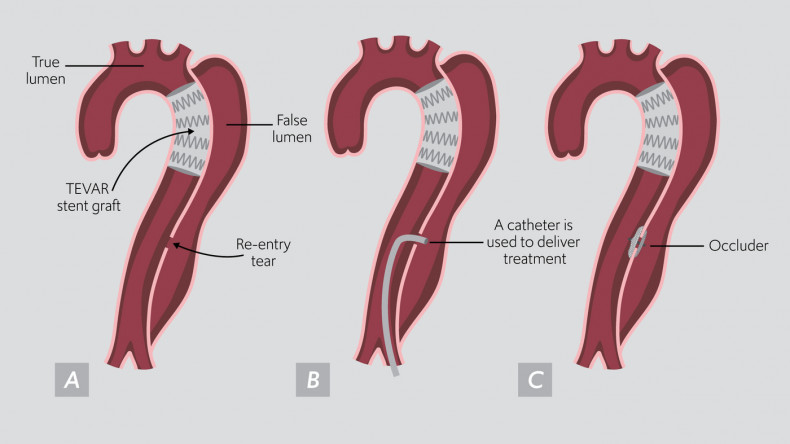Our cardiologists have pioneered a new minimally invasive procedure to repair false lumen expansion in the aorta, called FLIRT. It is used to seal a de novo or residual tear in the aortic wall following previous intervention, using advanced imaging techniques to guide treatment directly to where it is needed.

A CT scan of a successful FLIRT procedure that treats problematic tears in the aorta following previous interventions
Complications following aortic dissection
Aortic dissection is a life-threatening condition, seen mainly in people aged 60 and over. It is caused by an intimal tear of the aortic wall, which can result in blood entering the inner layers and creating a false lumen.
Over time, the false lumen can expand and weaken the aortic wall, resulting in a rupture which can be fatal.
TEVAR is the recommended treatment
A minimally invasive procedure called TEVAR (Thoracic EndoVascular Aortic Repair) is the recommended treatment for aortic dissection. This involves inserting a stent graft at the point of the aortic dissection via a small incision in the leg.
The procedure repairs the aorta from within and allows blood to be redirected down the true lumen, removing pressure from the torn section of the aorta.
The TEVAR procedure has a success rate of >90% in treating aortic dissection. It is also safer than the alternative treatment option of surgery, with a 4.9% lower risk of perioperative fatality (12.3% vs 17.2%).

(A) The entry tear of an aortic dissection can result in blood flowing in between the layers of the aortic wall, resulting in the development of a false lumen. (B) TEVAR is the recommended minimally invasive treatment, positioning a stent graft to bypass the tear, enabling blood to be redirected through the true lumen.
Using FLIRT to manage de novo and residual aortic tears
The success of endovascular management of aortic dissection with TEVAR depends on covering and bypassing the aortic tear to seal the false lumen.
In 2% of patients, the stent graft may move to re-expose the original entry tear or a new aortic tear may develop further down from the stent following a TEVAR intervention.
Unfortunately, this means blood can flow back into the false lumen, leading to expansion and increasing the risk of fatality once more.
Inserting an additional connecting stent graft with a further TEVAR procedure is not recommended because of the risk of side branch obstruction or spinal ischaemia. A focal approach is safer to occlude any re-entry tear, permitting the blood to continue flowing into the true lumen.
To overcome this problem, our cardiology experts have developed and pioneered an innovative and minimally invasive interventional procedure called FLIRT (False Lumen Intervention for the promotion of Remodelling and Thrombosis), that can seal a de novo or residual aortic tear.
What does the FLIRT procedure involve?

(A). A re-entry tear to the false lumen can appear after a TEVAR procedure, leading to repeat false lumen expansion. (B) The FLIRT procedure: A catheter is used to precisely target the tear leading into the false lumen, where an occluder is delivered to isolate the communication between the true and false lumen and promote thrombosis in the false lumen.
The FLIRT procedure uses advanced imaging techniques to guide a catheter and a wire (via a vein in the groin or arm) into the false lumen and between the delicate layers of the aortic wall to precisely seal the tear.
The method of sealing the tear will depend on the requirements of the patient and can include coils, occluders and vascular plugs.
The procedure prevents blood flow into and expansion of the false lumen and allows blood to flow correctly through the true lumen.

A patient case study: CT scans demonstrating repeat entry of blood into the false lumen following a TEVAR procedure. A vascular plug has been used to isolate the communication between the false and true lumen.
Our consultant cardiologist, Professor Christoph Nienaber, who pioneered the FLIRT and TEVAR procedures says, “In essence, FLIRT is a new technique to restore blood flow to normal, when de novo or residual aortic tears emerge after a TEVAR procedure, and thereby stabilises the aorta.”
Previously to this procedure, treatment was limited to medication to control a patient’s blood pressure to lower the risk of fatality with repeat false lumen expansion. The FLIRT procedure offers a new minimally invasive treatment for the underlying problem.
Patient follow-up is essential
“As most people experiencing problems with the false lumen are asymptomatic in the beginning, it is essential to follow up all TEVAR patients with clinical visits and imaging,” explains Professor Nienaber.
He estimates that two thirds of patients with this issue following a TEVAR procedure show no symptoms or very mild instances of tension, back pain or chest pain.
“It is best to get in to fix the problem as early as possible. If repeat false lumen expansion occurs, it is usually between three months and three years following a TEVAR procedure,” says Professor Nienaber.
We have an aortopathy clinic at our hospitals where we see patients three months after the TEVAR procedure and then at annual intervals – with CT imaging each time. If we find there is blood flow into the false lumen and expansion, we can carry out the FLIRT procedure to rectify the problem.
We monitor 300-400 patients each year and we have identified 16 patients so far in need of the FLIRT procedure. All procedures were successfully completed with no complications.
Contact us
For more information or to book an appointment, please contact our customer care team.
